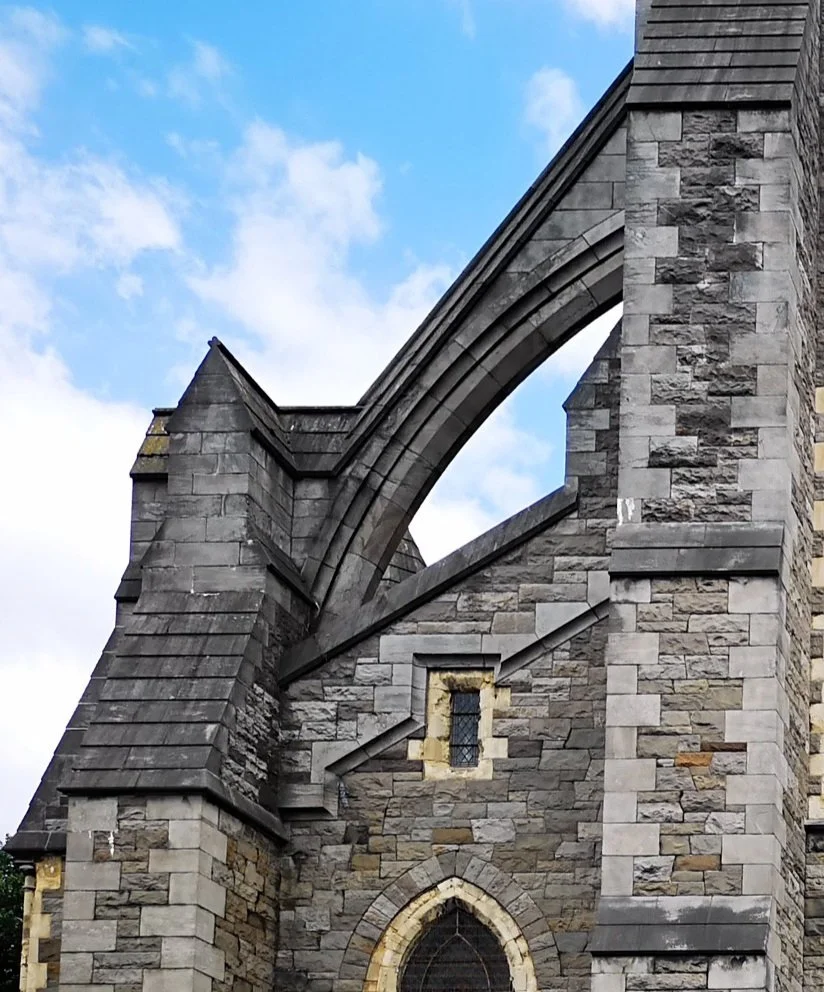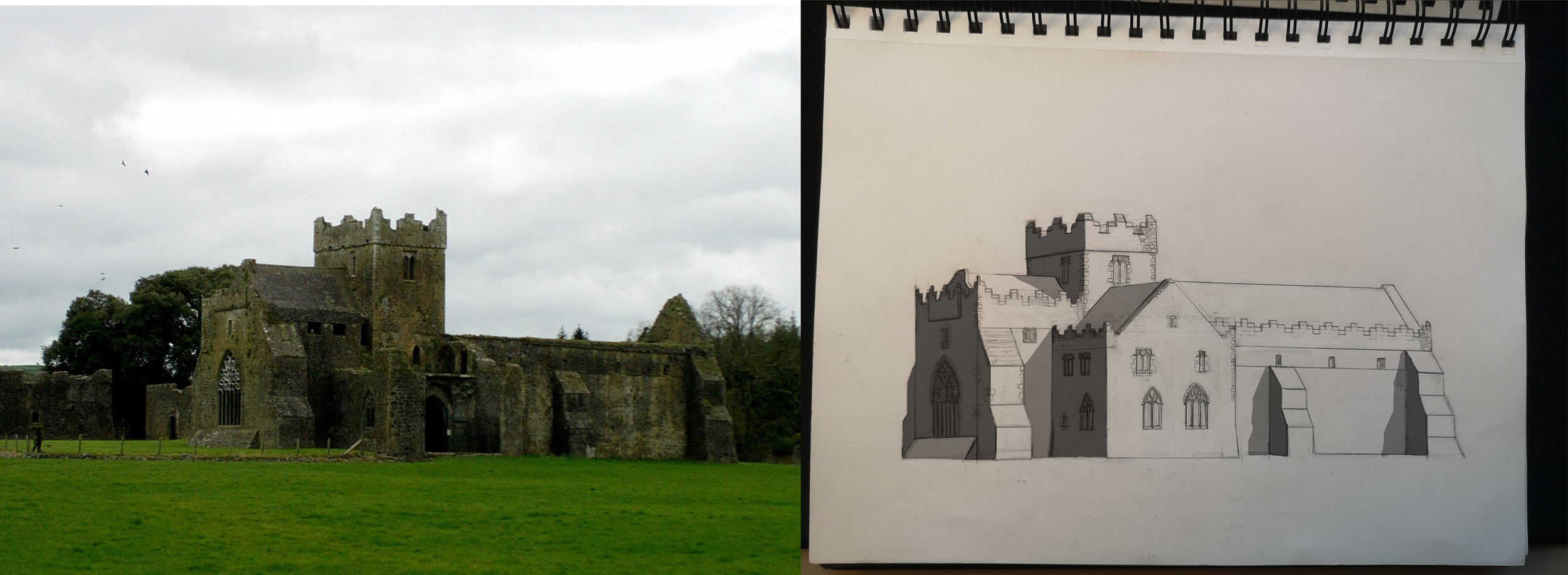Reconstructing Ruins: Part III The Gothic of Ireland
Dominican Black Abbey, Kilkenny. Photograph by Ian McKay
Gothic is a term often thrown around, whether referring to a style of dress, a medieval cathedral, or a band of German marauders. The gothic we are interested in is the architectural style and its effects in Ireland, but where did this style originate?
Lets take a step back to 1137 a.d. in France. An Abbot by the name Suger was in the market to construct a new section to his church, he didn’t want the dark interiors of Romanesque churches, but instead wanted a space that could be filled with God’s great light. To do this he knew he needed bigger windows than what the Romanesque offered. He got to work with his masons combining three new technological advancements into one building, The pointed arch, the ribbed vault, and last but not least the flying buttress. what he had made, took the medieval world by storm.
St. Denis Church by Suger, Photograph by Pierre Poschadel
The Gothic in Ireland
It was only a matter of time for the gothic to wash up upon Irish shores. At first only transitionary buildings were built, buildings which for all intents and purposes were Romanesque but with pointed windows.
Soon after, the gothic had fully captured the Irish imagination, leading them to build more churches in this style than any other.
The first gothic structures in Ireland were crude to say the least, the windows remained small and spread out, and the buttresses were wide and sparse, It was only after a few generations that the Irish started to understand and use the new gothic technological advancements to their advantage,
These structural advantages were realized, and Irish churches increased dramatically in size and scale. The introduction of the pointed arch allowed builders to balance the weight of stone walls much more effectively letting them build larger and taller than ever before.
This can be seen most aptly on the Rock of Cashel, where the gothic cathedral dwarfs the adjacent Romanesque Cormac’s chapel. the chapel is considered the most technologically sophisticated Romanesque chapel in Ireland, yet it still is dwarfed by the Cathedral with it’s taller (and thinner) walls
A flying Buttress from Christ Cathedral, Dublin
Now to the point of reconstruction. There were many buildings made in the gothic. Some great examples not only survived the ravages of time, but were restored to their full glory in the Victorian Era. Other buildings were not so lucky. Many unique and beautiful churches were destroyed, forgotten, and left to decay. Here are some examples of the ruins which shall be reconstructed here if but for a brief moment.
Kilcooley Abbey
Kilcooley Abbey Great Window
As with most abbey’s in Ireland, Kilcooley Abbey saw its end due to the reformation and the dissolution of the monasteries. It’s lands were granted to the Earl of Ormond, who first turned it into a fortified house, and then abandoned it. While this explains its current state, let us go back and rebuild its past.
The abbey was a prosperous place for hundreds of years and run by the Cistercians. however by the 15th century, Ireland was a dangerous place. Local tribes feuded and Anglo-Normans waged war. The abbey was attacked many times, but it was always repaired, always improved. Every time it was repaired, its grandeur was increased.
A great window was added to the sanctuary, with a new style from France. The Flamboyant gothic, a style that comes from the French ‘flame‘ but unlike in France, the Irish version is less about the flame, and more about the flower. Examples of this style can be seen all over Ireland, next time you are on a hike or taking a stroll near your local ruin, be sure to check out the windows.
A great sculpture of the crucifixion was carved into the south transept wall, A design which could only have been done by an Irish medieval mason. A Bell tower also rises up above the transepts and the north transept is built out to house side altars a stone vaulted ceiling. The Altar has the 12 apostles all carved upon it in their own niches.
Kilcooley Abbey is a perfect showcase of the medieval Irish Imagination. The gothic ideas imbued into stone. Key parts remain of the structure and a full restoration would do much to show off the great imagination and creativity of the Irish mason and artist.
Quin Franciscan Friary was once a large Normal castle built in 13th century. It was not long before the castle was attacked and destroyed by the fearsome MacNamara’s who later gifted it to the Franciscans in 1402, who set about transforming it into a friary. They kept some features, such as the bases of two on the towers and a thick wall from its old defensive days. They built out from the original castle plan and also built up, with a 5 story tower built in the center to project the sounds of its bell, throughout the pastures of Quin.
A settlement once bustled by the friary, but both the village, and the friary would meet their untimely fate by the 17th Century.
The friary was confiscated in 1541, but the lord who was granted rights of the land allowed the friars to stay. In 1640 the friary took on the role of a college with 800 students. In 1650 Cromwell captured the friary, executing the friars and destroying the friary. Not quite a happy ending, but every ruin has a fiery past.
Athassel Priory, The largest and grandest of all the priories in Ireland. The Priory stretched over 4 acres and remains of the outbuildings around the Priory still remain, such as a gatehouse, lodge, and bridge. The scale and growth of the abbey coincided with the founding and expansion of a large town nearby.
The Nave was expanded in width to increase its capacity and a beautiful rood screen once stood where the gothic window was blocked up (above). The tower once had great 30 ft arches holding it up on three sides that have now since been blocked up to create walls where open air once was.
The Priory was confiscated in 1537, during the dissolution of the monasteries, and it’s lands were given to the Earl of Ormond. In 1581 the vacant priory burnt, never to be repaired.
The artifacts of Athassel Priory have been lost, but the the architectural gems can be saved. if the tower was to be restored, the blocked up windows and arches could be shown in their full glory once more. The public could walk again in the breathtaking spaces that once occupied these grounds.
A blocked up tower Arch separating the North Transept from the sanctuary
While the chapter of Irish Medieval Gothic closed many centuries ago, these ruins have not been lost to history. They have endured many hardships and will endure many more.
Each of these ruins has a story to tell, and each of these ruins show in their own way the genius of the Irish gothic mind.
Whether it be the artistic sense of Celtic and Gothic sculpture, or the use of technology and Irish limestone to create beautiful, inspiring, and holy spaces, the Irish Romanesque and Gothic live side by side in Irish history. Both styles take their place upon stone thrones, embedding themselves permanently onto the face and into the history of the isle of saints and scholars.
Ian McKay,
February 2022.













